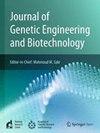超越已知:揭示印度新的旋毛虫基因型(T14和T15)的存在并扩大物种复合体
IF 2.8
Q3 Biochemistry, Genetics and Molecular Biology
Journal of Genetic Engineering and Biotechnology
Pub Date : 2025-05-26
DOI:10.1016/j.jgeb.2025.100512
引用次数: 0
摘要
旋毛虫物种复合体包括10个公认的物种和3个全球分布的基因型,对牲畜、野生动物和人类造成重大的健康和经济负担。在印度,旋毛虫病是一种未得到充分认识的人畜共患疾病。研究印度旋毛虫分离株的分类学地位、遗传多样性和系统地理学对了解该病的区域动态至关重要。本研究采用国际旋毛虫病委员会(ICT)推荐的多重PCR (mPCR),然后进行测序,以鉴定印度旋毛虫分离株直至物种水平。多重PCR检测结果显示,豹子和老虎感染内氏弓形虫或与布氏弓形虫混合感染的带型相似。然而,mPCR产品的测序显示碱基组成增加。利用5个核基因/区域(18S rRNA、5S ISR、ESV、ITS1和ITS2)和3个线粒体基因(coxI、cytb和mt-lsr)进行进一步的分子表征。基于分子标记(coxI, 5S ISR, ITS1和ITS2)的系统发育分析(最大似然和贝叶斯推断)突出了印度分离株之间的遗传变异,并将其定位为T. britovi或T. nelsoni的姐妹分支或作为一个独立的分类单元。此外,印度分离株的ESV可变区也呈现出一系列独特的核苷酸,明确区分了它们与已知的T. nelsoni和T. britovi序列。分子分析结果表明,6株分离株为nelsoni样种,为T14基因型;一个具有独特基因型的分离物,标记为基因型T15;3株分离株表现为布氏弓形虫和T14基因型混合感染。该研究表明存在两种新的旋毛虫基因型T14和T15,每种基因型都具有不同的遗传谱,强调了印度豹子和老虎作为旋毛虫哨兵宿主的作用。本文章由计算机程序翻译,如有差异,请以英文原文为准。
Beyond the known: Unraveling the existence of novel Trichinella genotypes (T14 and T15) in India and expanding the species complex
The Trichinella species complex includes 10 recognized species and three genotypes with global distribution, impacting significant health and economic burdens on livestock, wildlife, and humans. In India, trichinellosis is an under recognized zoonotic disease. Investigating the taxonomic status, genetic diversity and phylogeography of Indian Trichinella isolates is crucial for understanding the disease's regional dynamics. This study used International Commission on Trichinellosis (ICT) recommended multiplex PCR (mPCR) followed by sequencing for identification of the Indian Trichinella isolates up to species level. Multiplex PCR assay yielded band pattern similar to either single infection with T. nelsoni or mixed with T. britovi in leopards and tigers. However, sequencing of mPCR products revealed an increase in base composition. Further molecular characterization was performed using five nuclear genes/regions (18S rRNA, 5S ISR, ESV, ITS1, and ITS2), and three mitochondrial genes (coxI, cytb, and mt-lsr). Phylogenetic analyses (maximum likelihood and Bayesian inference) based on the molecular markers (coxI, 5S ISR, ITS1, and ITS2) highlighted the genetic variation among the Indian isolates, and positioned them as sister clades to T. britovi or T. nelsoni or as an independent taxon. Furthermore, the variable region of ESV also presented a series of unique nucleotides in the Indian isolates which unequivocally differentiated them from known T. nelsoni and T. britovi sequences. Based on the molecular data, six isolates were identified as T. nelsoni-like species, designated as T14 genotype; one isolate with a unique genotype, labelled as genotype T15; and three isolates exhibited mixed infections of T. britovi and the T14 genotype. This study suggests the presence of two novel Trichinella genotypes, T14 and T15, each with distinct genetic profile, emphasizing the role of leopards and tigers as sentinel hosts for Trichinella in India.
求助全文
通过发布文献求助,成功后即可免费获取论文全文。
去求助
来源期刊

Journal of Genetic Engineering and Biotechnology
Biochemistry, Genetics and Molecular Biology-Biotechnology
CiteScore
5.70
自引率
5.70%
发文量
159
审稿时长
16 weeks
期刊介绍:
Journal of genetic engineering and biotechnology is devoted to rapid publication of full-length research papers that leads to significant contribution in advancing knowledge in genetic engineering and biotechnology and provide novel perspectives in this research area. JGEB includes all major themes related to genetic engineering and recombinant DNA. The area of interest of JGEB includes but not restricted to: •Plant genetics •Animal genetics •Bacterial enzymes •Agricultural Biotechnology, •Biochemistry, •Biophysics, •Bioinformatics, •Environmental Biotechnology, •Industrial Biotechnology, •Microbial biotechnology, •Medical Biotechnology, •Bioenergy, Biosafety, •Biosecurity, •Bioethics, •GMOS, •Genomic, •Proteomic JGEB accepts
 求助内容:
求助内容: 应助结果提醒方式:
应助结果提醒方式:


